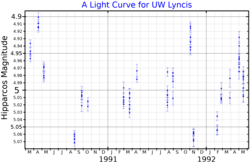
Summary
1 Lyncis is a single[5] star in the northern constellation of Lynx. It is also known by its variable star designation of UW Lyncis; 1 Lyncis is the Flamsteed designation. This object is visible to the naked eye as a faint, reddish-hued star with an apparent visual magnitude of 4.95.[3] It is moving further from the Earth with a heliocentric radial velocity of 12 km/s.[7]
| Observation data Epoch J2000 Equinox J2000 | |
|---|---|
| Constellation | Lynx |
| Right ascension | 06h 17m 54.81907s[2] |
| Declination | +61° 30′ 55.0251″[2] |
| Apparent magnitude (V) | 4.95[3] |
| Characteristics | |
| Evolutionary stage | asymptotic giant branch[4] |
| Spectral type | M3IIIab[5] |
| U−B color index | +1.96[3] |
| B−V color index | +1.83[3] |
| Variable type | Lb?[6] |
| Astrometry | |
| Radial velocity (Rv) | +11.56±0.44[7] km/s |
| Proper motion (μ) | RA: −10.59±0.36[2] mas/yr Dec.: −3.11±0.29[2] mas/yr |
| Parallax (π) | 5.11 ± 0.33 mas[2] |
| Distance | 640 ± 40 ly (200 ± 10 pc) |
| Absolute magnitude (MV) | −1.44[8] |
| Details | |
| Radius | 156[9] R☉ |
| Luminosity | 2,848[10] L☉ |
| Temperature | 3,485[10] K |
| Other designations | |
| Database references | |
| SIMBAD | data |
The star is an aging red giant of spectral type M3IIIab,[5] currently on the asymptotic giant branch,[4] having exhausted the hydrogen at its core and evolved away from the main sequence. It has been classified as a possible slow irregular variable,[6] after being found to be slightly variable in 1969 by Olin J. Eggen.[12] Its changes in brightness are complex, with two shorter changeable periods of 35–40 and 47–50 days due to the star's pulsations, and a longer period of 1,500 days possibly due to the star's rotation or convectively induced oscillatory thermal (COT) mode.[13] The star has expanded to 156[9] times the Sun's radius and it is radiating 2,848[10] times the luminosity of the Sun from its enlarged photosphere at an effective temperature of 3,485 K.[10]
References edit
- ^ "/ftp/cats/more/HIP/cdroms/cats". Centre de Données astronomiques de Strasbourg. Strasbourg astronomical Data Center. Retrieved 15 October 2022.
- ^ a b c d e van Leeuwen, F. (2007). "Validation of the new Hipparcos reduction". Astronomy and Astrophysics. 474 (2): 653–664. arXiv:0708.1752. Bibcode:2007A&A...474..653V. doi:10.1051/0004-6361:20078357. S2CID 18759600.
- ^ a b c d Mermilliod, J.-C. (1986). "Compilation of Eggen's UBV data, transformed to UBV (unpublished)". Catalogue of Eggen's UBV Data. SIMBAD. Bibcode:1986EgUBV........0M.
- ^ a b Eggen, Olin J. (July 1992), "Asymptotic giant branch stars near the sun", Astronomical Journal, 104 (1): 275–313, Bibcode:1992AJ....104..275E, doi:10.1086/116239.
- ^ a b c Eggleton, P. P.; Tokovinin, A. A. (2008). "A catalogue of multiplicity among bright stellar systems". Monthly Notices of the Royal Astronomical Society. 389 (2): 869. arXiv:0806.2878. Bibcode:2008MNRAS.389..869E. doi:10.1111/j.1365-2966.2008.13596.x. S2CID 14878976.
- ^ a b Watson, Christopher (4 January 2010). "UW Lyncis". AAVSO Website. American Association of Variable Star Observers. Retrieved 10 March 2016.
- ^ a b Famaey, B.; et al. (2005). "Local kinematics of K and M giants from CORAVEL/Hipparcos/Tycho-2 data. Revisiting the concept of superclusters". Astronomy and Astrophysics. 430: 165–186. arXiv:astro-ph/0409579. Bibcode:2005A&A...430..165F. doi:10.1051/0004-6361:20041272. S2CID 17804304.
- ^ Anderson, E.; Francis, Ch. (2012). "XHIP: An extended hipparcos compilation". Astronomy Letters. 38 (5): 331. arXiv:1108.4971. Bibcode:2012AstL...38..331A. doi:10.1134/S1063773712050015. S2CID 119257644.
- ^ a b Brown, A. G. A.; et al. (Gaia collaboration) (August 2018). "Gaia Data Release 2: Summary of the contents and survey properties". Astronomy & Astrophysics. 616. A1. arXiv:1804.09365. Bibcode:2018A&A...616A...1G. doi:10.1051/0004-6361/201833051. Gaia DR2 record for this source at VizieR.
- ^ a b c d McDonald, I.; et al. (2012). "Fundamental Parameters and Infrared Excesses of Hipparcos Stars". Monthly Notices of the Royal Astronomical Society. 427 (1): 343–57. arXiv:1208.2037. Bibcode:2012MNRAS.427..343M. doi:10.1111/j.1365-2966.2012.21873.x. S2CID 118665352.
- ^ "1 Lyncis". SIMBAD. Centre de données astronomiques de Strasbourg. Retrieved 9 March 2016.
- ^ Eggen, Olin J. (1969). "Light Variations of Small Amplitude in the Red Giants of the Disc Population". Information Bulletin on Variable Stars. 355 (355, #1. (IBVS Homepage)): 1. Bibcode:1969IBVS..355....1E.
- ^ Percy, John R.; Wilson, Joseph B.; Henry, Gregory W. (2001). "Long-Term VRI Photometry of Small-Amplitude Red Variables. I. Light Curves and Periods". The Publications of the Astronomical Society of the Pacific. 113 (786): 983–96. Bibcode:2001PASP..113..983P. doi:10.1086/322153.



